Comparison of Psychoanalytic and Behavioural Approaches in Psychology
VerifiedAdded on 2023/04/05
|11
|2301
|168
AI Summary
This assignment compares the psychoanalytic approach with the behaviour model of learning in psychology. It discusses the key differences in assumptions, the influence of environmental stimuli, and the concept of 'id'. It also explores the strengths and weaknesses of both approaches. The assignment includes a case study analysis and concludes with a discussion on the importance of psychology in understanding human behavior.
Contribute Materials
Your contribution can guide someone’s learning journey. Share your
documents today.
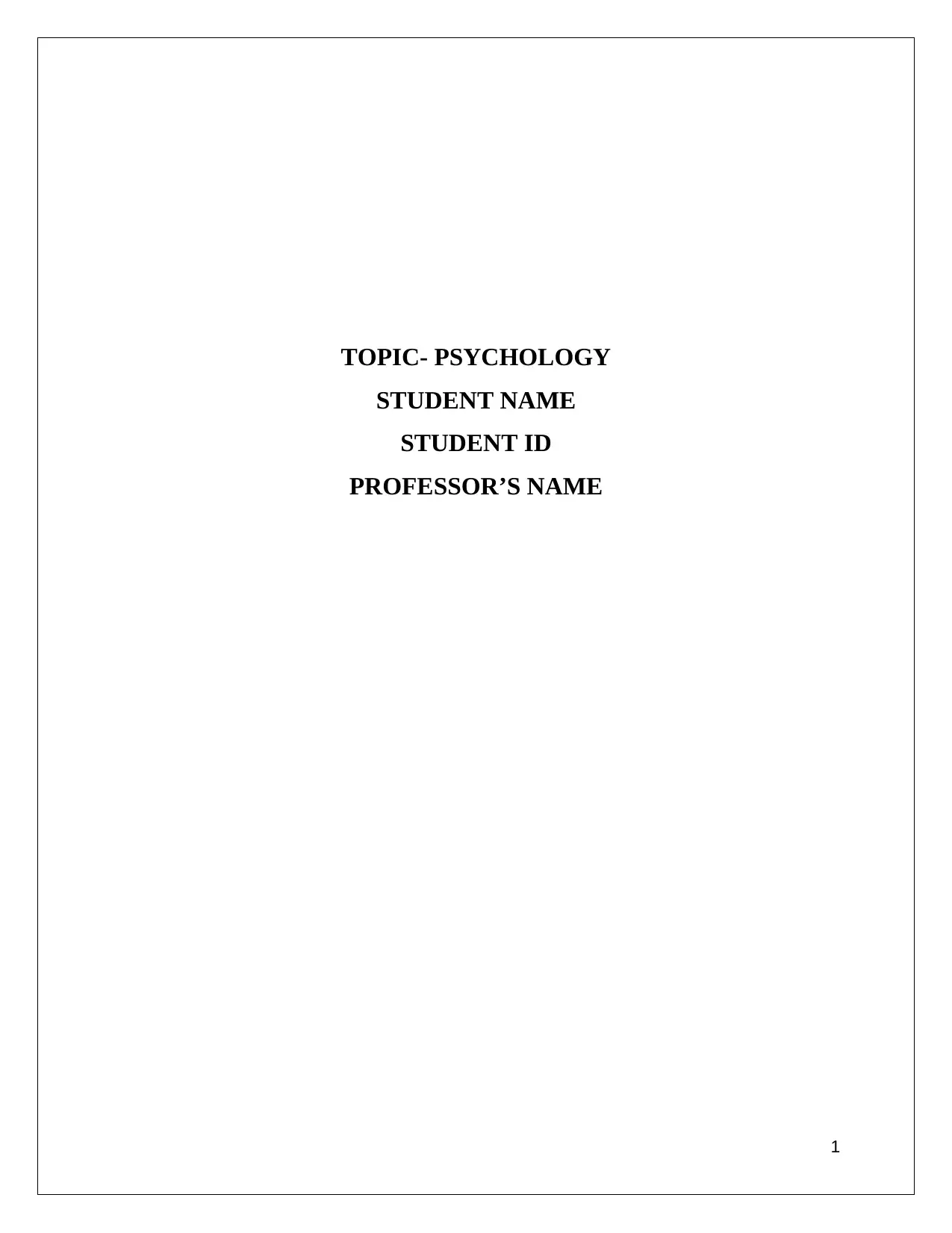
TOPIC- PSYCHOLOGY
STUDENT NAME
STUDENT ID
PROFESSOR’S NAME
1
STUDENT NAME
STUDENT ID
PROFESSOR’S NAME
1
Secure Best Marks with AI Grader
Need help grading? Try our AI Grader for instant feedback on your assignments.

Table of content
Introduction......................................................................................................................................3
Task 1: Psychoanalytic and Behaviour............................................................................................3
Compare the psychoanalytic approach with the behaviour model of learning................................3
Key difference in the assumption....................................................................................................4
Influence of environmental stimuli and concept of ‘id’.................................................................5
Strength and weakness.....................................................................................................................5
Task 2...............................................................................................................................................7
States the strength and weakness of natural and artificial setting of both case study.....................7
Task 3...............................................................................................................................................9
An argument based on the case study of zimbardo.........................................................................9
Conclusion.....................................................................................................................................10
Reference List................................................................................................................................11
2
Introduction......................................................................................................................................3
Task 1: Psychoanalytic and Behaviour............................................................................................3
Compare the psychoanalytic approach with the behaviour model of learning................................3
Key difference in the assumption....................................................................................................4
Influence of environmental stimuli and concept of ‘id’.................................................................5
Strength and weakness.....................................................................................................................5
Task 2...............................................................................................................................................7
States the strength and weakness of natural and artificial setting of both case study.....................7
Task 3...............................................................................................................................................9
An argument based on the case study of zimbardo.........................................................................9
Conclusion.....................................................................................................................................10
Reference List................................................................................................................................11
2
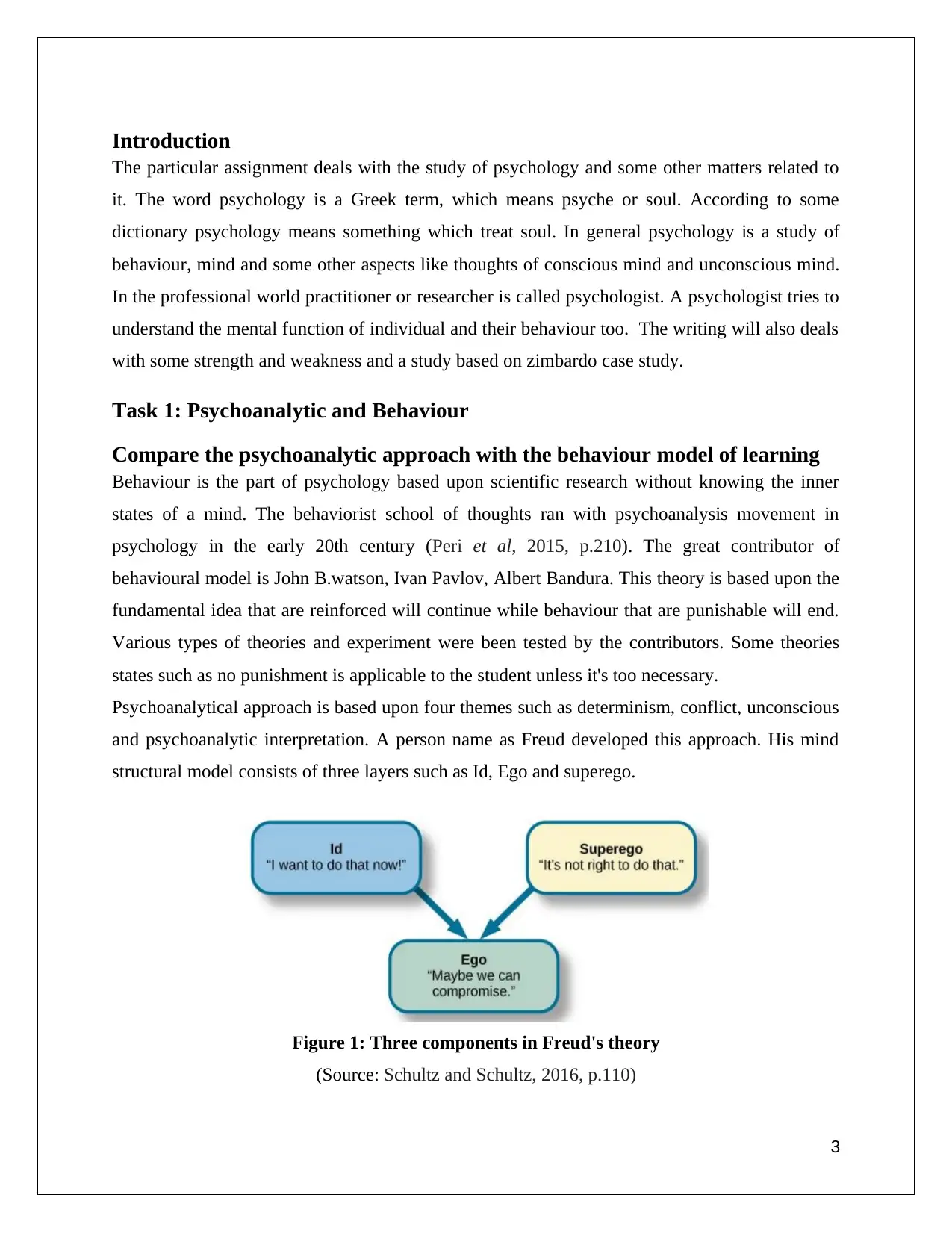
Introduction
The particular assignment deals with the study of psychology and some other matters related to
it. The word psychology is a Greek term, which means psyche or soul. According to some
dictionary psychology means something which treat soul. In general psychology is a study of
behaviour, mind and some other aspects like thoughts of conscious mind and unconscious mind.
In the professional world practitioner or researcher is called psychologist. A psychologist tries to
understand the mental function of individual and their behaviour too. The writing will also deals
with some strength and weakness and a study based on zimbardo case study.
Task 1: Psychoanalytic and Behaviour
Compare the psychoanalytic approach with the behaviour model of learning
Behaviour is the part of psychology based upon scientific research without knowing the inner
states of a mind. The behaviorist school of thoughts ran with psychoanalysis movement in
psychology in the early 20th century (Peri et al, 2015, p.210). The great contributor of
behavioural model is John B.watson, Ivan Pavlov, Albert Bandura. This theory is based upon the
fundamental idea that are reinforced will continue while behaviour that are punishable will end.
Various types of theories and experiment were been tested by the contributors. Some theories
states such as no punishment is applicable to the student unless it's too necessary.
Psychoanalytical approach is based upon four themes such as determinism, conflict, unconscious
and psychoanalytic interpretation. A person name as Freud developed this approach. His mind
structural model consists of three layers such as Id, Ego and superego.
Figure 1: Three components in Freud's theory
(Source: Schultz and Schultz, 2016, p.110)
3
The particular assignment deals with the study of psychology and some other matters related to
it. The word psychology is a Greek term, which means psyche or soul. According to some
dictionary psychology means something which treat soul. In general psychology is a study of
behaviour, mind and some other aspects like thoughts of conscious mind and unconscious mind.
In the professional world practitioner or researcher is called psychologist. A psychologist tries to
understand the mental function of individual and their behaviour too. The writing will also deals
with some strength and weakness and a study based on zimbardo case study.
Task 1: Psychoanalytic and Behaviour
Compare the psychoanalytic approach with the behaviour model of learning
Behaviour is the part of psychology based upon scientific research without knowing the inner
states of a mind. The behaviorist school of thoughts ran with psychoanalysis movement in
psychology in the early 20th century (Peri et al, 2015, p.210). The great contributor of
behavioural model is John B.watson, Ivan Pavlov, Albert Bandura. This theory is based upon the
fundamental idea that are reinforced will continue while behaviour that are punishable will end.
Various types of theories and experiment were been tested by the contributors. Some theories
states such as no punishment is applicable to the student unless it's too necessary.
Psychoanalytical approach is based upon four themes such as determinism, conflict, unconscious
and psychoanalytic interpretation. A person name as Freud developed this approach. His mind
structural model consists of three layers such as Id, Ego and superego.
Figure 1: Three components in Freud's theory
(Source: Schultz and Schultz, 2016, p.110)
3

He also added that human behaviour is based upon these three components. According to Freud
a human personality is developed from the childhood and little changes in the adult stage. During
each stage child is conflict between biological and social expectations (Schultz and Schultz,
2016, p.110). His theories even had some drawback such as Narrow focus, no scientific basis and
misogyny.
Key difference in the assumption
Difference between psychoanalysis and behaviorism is a topic which is very necessary to study
for psychology study. Psychoanalytic is the study of mind and behaviour compared to its inner
states of mind, developed by Sigmund Freud whereas behaviorist is just concentrated upon the
general behaviour of a person that external, developed by Ivan Pavolv, John Watson etc.
Behaviorist is been followed by many theories and experiments with animals such as dogs, rats
and pigeons (Riding and Rayner, 2013, p.65). Psychoanalysis is based upon various stages such
as oral stage, anal stage, phallic stage, Latency stage and Genital stage. Major difference is:
● Psychoanalysis is based upon human mind and inner states of mind where as behaviorist
is related school of thoughts and mined behaviour.
● Psychoanalysis lays on the unconscious motivates behaviour whereas behaviorist beliefs
on learning and external stimuli.
● Psychoanalysis gives more stress to experiments and laboratory work whereas behaviorist
pays more attention to theories such as classical and operant.
● Psychoanalysis even gives stress to past history, explores relationships whereas
behaviorism is more simplistic approach
● Psychoanalysis uses patient’s unconscious conflicts. This will give benefit to the patient
and thus the reason for abnormal behaviour will be discovered, whereas behaviorism uses
learning principles to understand the behaviour of the patients. It focuses on the
behaviour instead of underlying cause (Stolorow et al, 2014, p.85).
● Psychoanalysis uses five therapies such as free association, dream analysis, analyzing
resistance, analyzing transference and interpretation, whereas behaviorist focus on
conditioning techniques and reinforcement.
4
a human personality is developed from the childhood and little changes in the adult stage. During
each stage child is conflict between biological and social expectations (Schultz and Schultz,
2016, p.110). His theories even had some drawback such as Narrow focus, no scientific basis and
misogyny.
Key difference in the assumption
Difference between psychoanalysis and behaviorism is a topic which is very necessary to study
for psychology study. Psychoanalytic is the study of mind and behaviour compared to its inner
states of mind, developed by Sigmund Freud whereas behaviorist is just concentrated upon the
general behaviour of a person that external, developed by Ivan Pavolv, John Watson etc.
Behaviorist is been followed by many theories and experiments with animals such as dogs, rats
and pigeons (Riding and Rayner, 2013, p.65). Psychoanalysis is based upon various stages such
as oral stage, anal stage, phallic stage, Latency stage and Genital stage. Major difference is:
● Psychoanalysis is based upon human mind and inner states of mind where as behaviorist
is related school of thoughts and mined behaviour.
● Psychoanalysis lays on the unconscious motivates behaviour whereas behaviorist beliefs
on learning and external stimuli.
● Psychoanalysis gives more stress to experiments and laboratory work whereas behaviorist
pays more attention to theories such as classical and operant.
● Psychoanalysis even gives stress to past history, explores relationships whereas
behaviorism is more simplistic approach
● Psychoanalysis uses patient’s unconscious conflicts. This will give benefit to the patient
and thus the reason for abnormal behaviour will be discovered, whereas behaviorism uses
learning principles to understand the behaviour of the patients. It focuses on the
behaviour instead of underlying cause (Stolorow et al, 2014, p.85).
● Psychoanalysis uses five therapies such as free association, dream analysis, analyzing
resistance, analyzing transference and interpretation, whereas behaviorist focus on
conditioning techniques and reinforcement.
4
Secure Best Marks with AI Grader
Need help grading? Try our AI Grader for instant feedback on your assignments.

Influence of environmental stimuli and concept of ‘id’
The importance environmental stimuli as give more stress to childhood experience, address to
the importance of unconscious mind, sexual or aggressive drives. It even paid attention towards
why every individual reacts to the different situation in a different way. Still have some
drawbacks such as it failed to explain impact of the environment, lacking empirical data and
even lack consideration of culture (Friedlander, 2013, p.130). This theory is based upon the
fundamental idea that are reinforced will continue while behaviour that are punishable will end.
Various types of theories and experiment were been tested by the contributors. Some theories
states such as no punishment is applicable to the student unless it's too necessary.
Concept of ‘id’ is the most primitive among other three structures and focus upon physical needs
and urges. It works on outside of conscious thoughts. Freud believes in this stage as Id is
regularly fighting to have our way in everything we undertake. Id is the only component among
the three that is been present from the birth, Id is the main root of all psychic energy and thus
make this as a primary components. Id is as important as promotes to fulfill the needs. For eg
increase in hunger and thirst should immediately provokes us to drinks and eat water or food. If
the needs are hungry or feeling uncomfortable then he or she will cry until and unless his
demands id fulfilled.
Strength and weakness
Psychoanalytic:
Strength: a) Offer in depth and tries to explore the origins of psychopathology. b) Always focus
on developmental. c)most of the stage stress on sexuality and give clear idea about its behaviour.
d) Focus on the gender issues. e) Transcends theory based on several models. f) Focus on issue
related to relationship. h) Self psychology confirms by neurobiological literature. i) Theories are
universal (Haslam et al, 2015, p.134).
Weakness: a) it confuses more than clarifying the concepts. b) Some idea is very outdated and is
questioned by many theorists. c) Lack intervention and low focus on techniques. d) More focus
on past can lead to analysis paralysis. e) Often avoid cultural, biological and social aspects.
5
The importance environmental stimuli as give more stress to childhood experience, address to
the importance of unconscious mind, sexual or aggressive drives. It even paid attention towards
why every individual reacts to the different situation in a different way. Still have some
drawbacks such as it failed to explain impact of the environment, lacking empirical data and
even lack consideration of culture (Friedlander, 2013, p.130). This theory is based upon the
fundamental idea that are reinforced will continue while behaviour that are punishable will end.
Various types of theories and experiment were been tested by the contributors. Some theories
states such as no punishment is applicable to the student unless it's too necessary.
Concept of ‘id’ is the most primitive among other three structures and focus upon physical needs
and urges. It works on outside of conscious thoughts. Freud believes in this stage as Id is
regularly fighting to have our way in everything we undertake. Id is the only component among
the three that is been present from the birth, Id is the main root of all psychic energy and thus
make this as a primary components. Id is as important as promotes to fulfill the needs. For eg
increase in hunger and thirst should immediately provokes us to drinks and eat water or food. If
the needs are hungry or feeling uncomfortable then he or she will cry until and unless his
demands id fulfilled.
Strength and weakness
Psychoanalytic:
Strength: a) Offer in depth and tries to explore the origins of psychopathology. b) Always focus
on developmental. c)most of the stage stress on sexuality and give clear idea about its behaviour.
d) Focus on the gender issues. e) Transcends theory based on several models. f) Focus on issue
related to relationship. h) Self psychology confirms by neurobiological literature. i) Theories are
universal (Haslam et al, 2015, p.134).
Weakness: a) it confuses more than clarifying the concepts. b) Some idea is very outdated and is
questioned by many theorists. c) Lack intervention and low focus on techniques. d) More focus
on past can lead to analysis paralysis. e) Often avoid cultural, biological and social aspects.
5
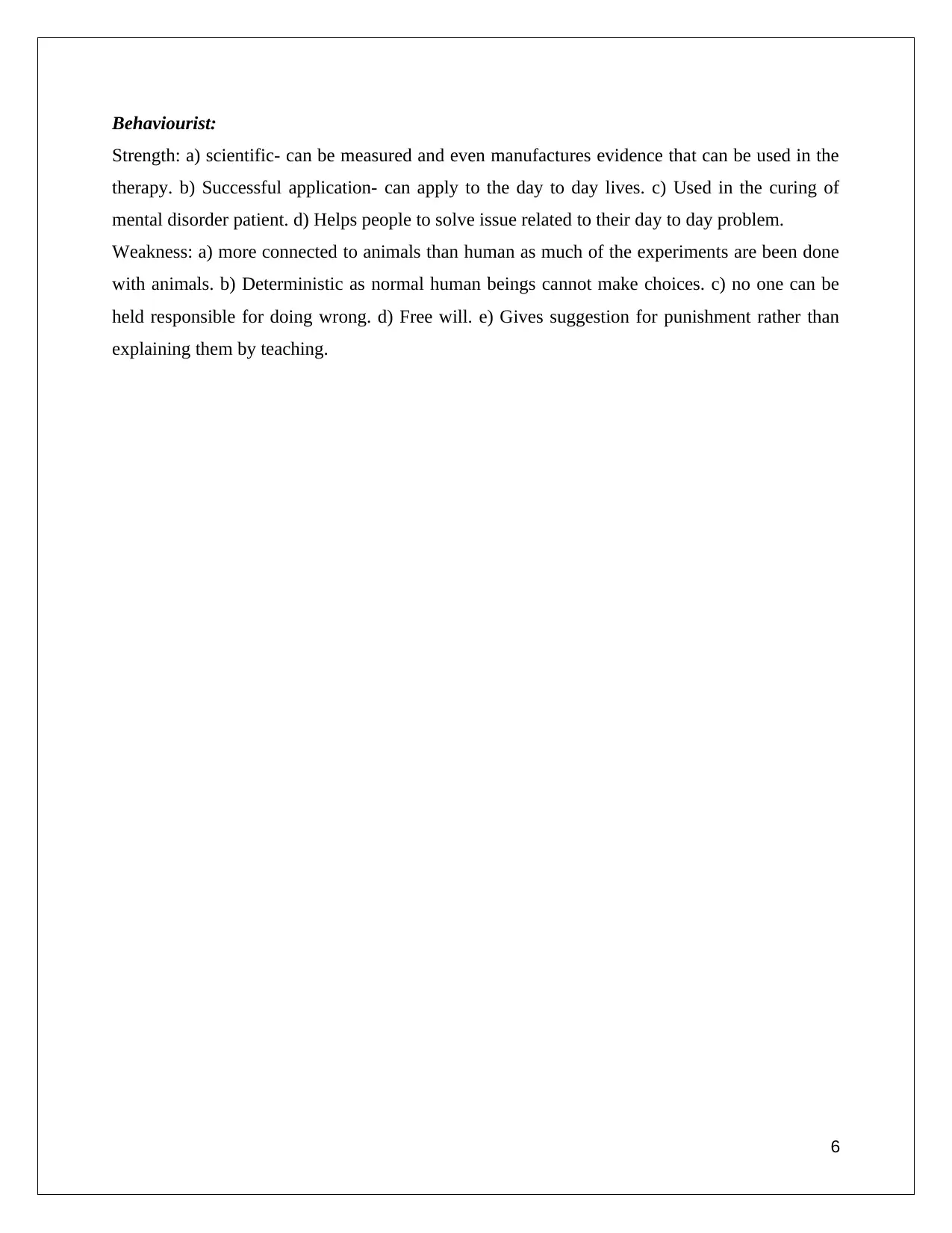
Behaviourist:
Strength: a) scientific- can be measured and even manufactures evidence that can be used in the
therapy. b) Successful application- can apply to the day to day lives. c) Used in the curing of
mental disorder patient. d) Helps people to solve issue related to their day to day problem.
Weakness: a) more connected to animals than human as much of the experiments are been done
with animals. b) Deterministic as normal human beings cannot make choices. c) no one can be
held responsible for doing wrong. d) Free will. e) Gives suggestion for punishment rather than
explaining them by teaching.
6
Strength: a) scientific- can be measured and even manufactures evidence that can be used in the
therapy. b) Successful application- can apply to the day to day lives. c) Used in the curing of
mental disorder patient. d) Helps people to solve issue related to their day to day problem.
Weakness: a) more connected to animals than human as much of the experiments are been done
with animals. b) Deterministic as normal human beings cannot make choices. c) no one can be
held responsible for doing wrong. d) Free will. e) Gives suggestion for punishment rather than
explaining them by teaching.
6
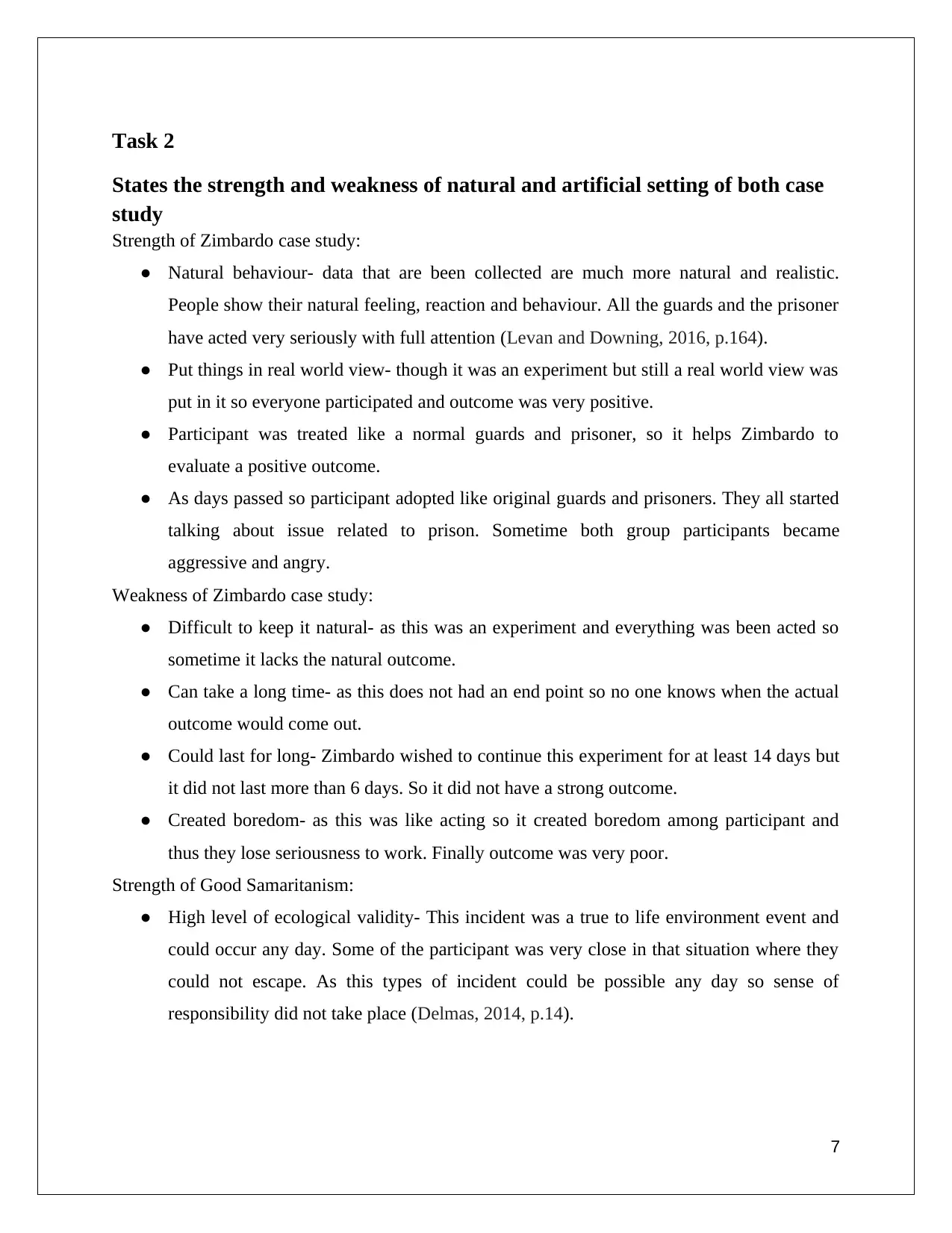
Task 2
States the strength and weakness of natural and artificial setting of both case
study
Strength of Zimbardo case study:
● Natural behaviour- data that are been collected are much more natural and realistic.
People show their natural feeling, reaction and behaviour. All the guards and the prisoner
have acted very seriously with full attention (Levan and Downing, 2016, p.164).
● Put things in real world view- though it was an experiment but still a real world view was
put in it so everyone participated and outcome was very positive.
● Participant was treated like a normal guards and prisoner, so it helps Zimbardo to
evaluate a positive outcome.
● As days passed so participant adopted like original guards and prisoners. They all started
talking about issue related to prison. Sometime both group participants became
aggressive and angry.
Weakness of Zimbardo case study:
● Difficult to keep it natural- as this was an experiment and everything was been acted so
sometime it lacks the natural outcome.
● Can take a long time- as this does not had an end point so no one knows when the actual
outcome would come out.
● Could last for long- Zimbardo wished to continue this experiment for at least 14 days but
it did not last more than 6 days. So it did not have a strong outcome.
● Created boredom- as this was like acting so it created boredom among participant and
thus they lose seriousness to work. Finally outcome was very poor.
Strength of Good Samaritanism:
● High level of ecological validity- This incident was a true to life environment event and
could occur any day. Some of the participant was very close in that situation where they
could not escape. As this types of incident could be possible any day so sense of
responsibility did not take place (Delmas, 2014, p.14).
7
States the strength and weakness of natural and artificial setting of both case
study
Strength of Zimbardo case study:
● Natural behaviour- data that are been collected are much more natural and realistic.
People show their natural feeling, reaction and behaviour. All the guards and the prisoner
have acted very seriously with full attention (Levan and Downing, 2016, p.164).
● Put things in real world view- though it was an experiment but still a real world view was
put in it so everyone participated and outcome was very positive.
● Participant was treated like a normal guards and prisoner, so it helps Zimbardo to
evaluate a positive outcome.
● As days passed so participant adopted like original guards and prisoners. They all started
talking about issue related to prison. Sometime both group participants became
aggressive and angry.
Weakness of Zimbardo case study:
● Difficult to keep it natural- as this was an experiment and everything was been acted so
sometime it lacks the natural outcome.
● Can take a long time- as this does not had an end point so no one knows when the actual
outcome would come out.
● Could last for long- Zimbardo wished to continue this experiment for at least 14 days but
it did not last more than 6 days. So it did not have a strong outcome.
● Created boredom- as this was like acting so it created boredom among participant and
thus they lose seriousness to work. Finally outcome was very poor.
Strength of Good Samaritanism:
● High level of ecological validity- This incident was a true to life environment event and
could occur any day. Some of the participant was very close in that situation where they
could not escape. As this types of incident could be possible any day so sense of
responsibility did not take place (Delmas, 2014, p.14).
7
Paraphrase This Document
Need a fresh take? Get an instant paraphrase of this document with our AI Paraphraser
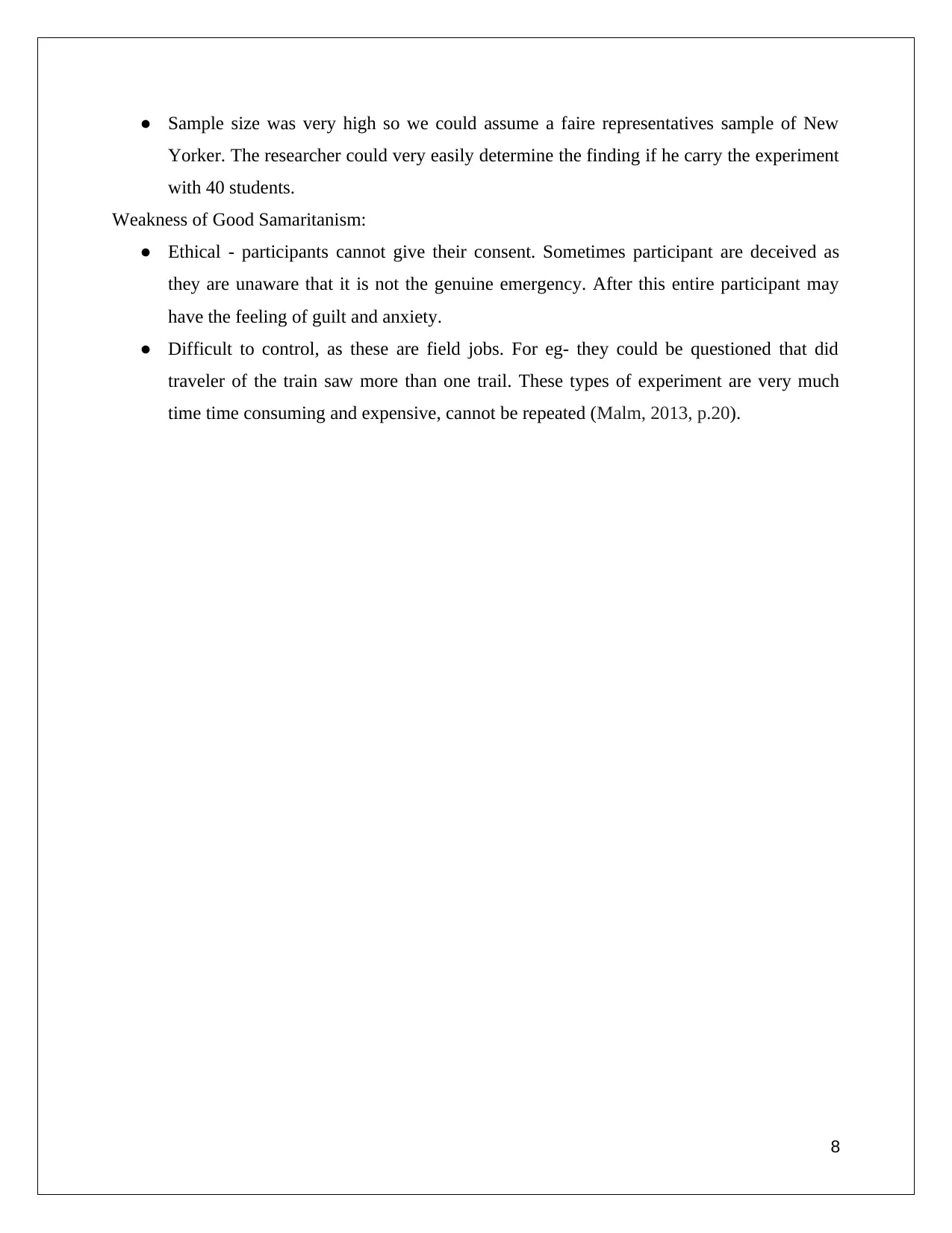
● Sample size was very high so we could assume a faire representatives sample of New
Yorker. The researcher could very easily determine the finding if he carry the experiment
with 40 students.
Weakness of Good Samaritanism:
● Ethical - participants cannot give their consent. Sometimes participant are deceived as
they are unaware that it is not the genuine emergency. After this entire participant may
have the feeling of guilt and anxiety.
● Difficult to control, as these are field jobs. For eg- they could be questioned that did
traveler of the train saw more than one trail. These types of experiment are very much
time time consuming and expensive, cannot be repeated (Malm, 2013, p.20).
8
Yorker. The researcher could very easily determine the finding if he carry the experiment
with 40 students.
Weakness of Good Samaritanism:
● Ethical - participants cannot give their consent. Sometimes participant are deceived as
they are unaware that it is not the genuine emergency. After this entire participant may
have the feeling of guilt and anxiety.
● Difficult to control, as these are field jobs. For eg- they could be questioned that did
traveler of the train saw more than one trail. These types of experiment are very much
time time consuming and expensive, cannot be repeated (Malm, 2013, p.20).
8

Task 3
An argument based on the case study of zimbardo
Zimbardo conducted an experiment related to the guards and prisoner’s behaviour so he
converted the psychology building into a mock prison. He offered the role of guards and prisoner
to the various students, 70 applicants shown interest out of which 24 were selected according to
the interviews and personality test. Even he was paid $15 per day to take part in the experiment.
Participant was randomly selected for guards and prisoners as tried to keep the situation as much
real as possible. Prisoners were treated like criminal and they even respected guards like a jail
guards. As days passed guards begins to harass the prisoners and they even behaved rudely and
brutally that after sometime relationship between them changes. Sometimes the prisoner even
protested and revolted. As this case was artificially arranged so it lack natural environment,
could not last for very long time. Natural behaviour data that are been collected are much more
natural and realistic. People show their natural feeling, reaction and behaviour. All the guards
and the prisoner have acted very seriously with full attention (Watson et al, 2016, p.147).
Created boredom as this was like acting so it created boredom among participant and thus they
lose seriousness to work. Finally outcome was very poor. Put things in real world view- though it
was an experiment but still a real world view was put in it so everyone participated and outcome
was very positive.
Participant was treated like a normal guards and prisoner, so it helps Zimbardo to evaluate a
positive outcome. According to the British psychological society (BPS) code of Human Research
Ethics (2014) its states some aspects such as value statement, ethics standards. Maximizing
benefits and minimising harm as all stages of works gets benefited and thus risk percentage
reduces. Even social responsibility increases the evolution of social structure in relation with
social needs. Unnecessary matter should be avoided unless psychologist judges the benefits. This
writing concludes with the Principles of BPS code. Zimbardo case study is an artificial one and
thus helped to start the experiment positively. But did not last till it final stage. Starting stage was
very effective as both the participant, guards and prisoner participated very well.
9
An argument based on the case study of zimbardo
Zimbardo conducted an experiment related to the guards and prisoner’s behaviour so he
converted the psychology building into a mock prison. He offered the role of guards and prisoner
to the various students, 70 applicants shown interest out of which 24 were selected according to
the interviews and personality test. Even he was paid $15 per day to take part in the experiment.
Participant was randomly selected for guards and prisoners as tried to keep the situation as much
real as possible. Prisoners were treated like criminal and they even respected guards like a jail
guards. As days passed guards begins to harass the prisoners and they even behaved rudely and
brutally that after sometime relationship between them changes. Sometimes the prisoner even
protested and revolted. As this case was artificially arranged so it lack natural environment,
could not last for very long time. Natural behaviour data that are been collected are much more
natural and realistic. People show their natural feeling, reaction and behaviour. All the guards
and the prisoner have acted very seriously with full attention (Watson et al, 2016, p.147).
Created boredom as this was like acting so it created boredom among participant and thus they
lose seriousness to work. Finally outcome was very poor. Put things in real world view- though it
was an experiment but still a real world view was put in it so everyone participated and outcome
was very positive.
Participant was treated like a normal guards and prisoner, so it helps Zimbardo to evaluate a
positive outcome. According to the British psychological society (BPS) code of Human Research
Ethics (2014) its states some aspects such as value statement, ethics standards. Maximizing
benefits and minimising harm as all stages of works gets benefited and thus risk percentage
reduces. Even social responsibility increases the evolution of social structure in relation with
social needs. Unnecessary matter should be avoided unless psychologist judges the benefits. This
writing concludes with the Principles of BPS code. Zimbardo case study is an artificial one and
thus helped to start the experiment positively. But did not last till it final stage. Starting stage was
very effective as both the participant, guards and prisoner participated very well.
9

Conclusion
The assignment conclude as that psychological study are been part of this world from very
ancient age, Egypt, India, China were engaged in this study. Gustav Fechner conducted
psychophysics research in 1830s. Major school of thoughts was biological, behavioral, cognitive,
social and psychoanalysis. There are some themes such as personality, unconscious mind,
motivation, development, genes and environment. Qualitative psychological research includes
interviews, participant observation and even individual observation. A psychologist tries to
understand the mental function of individual and their behaviour too. The two case studies also
gave an idea about psychology. Good samaritanism: an underground phenomenon is a natural
setting whereas zimbardo case study is artificial setting. We even came to know about the
difference between a case of artificial and natural. Psychology varies from person to person and
even some time it varies from various situations.
10
The assignment conclude as that psychological study are been part of this world from very
ancient age, Egypt, India, China were engaged in this study. Gustav Fechner conducted
psychophysics research in 1830s. Major school of thoughts was biological, behavioral, cognitive,
social and psychoanalysis. There are some themes such as personality, unconscious mind,
motivation, development, genes and environment. Qualitative psychological research includes
interviews, participant observation and even individual observation. A psychologist tries to
understand the mental function of individual and their behaviour too. The two case studies also
gave an idea about psychology. Good samaritanism: an underground phenomenon is a natural
setting whereas zimbardo case study is artificial setting. We even came to know about the
difference between a case of artificial and natural. Psychology varies from person to person and
even some time it varies from various situations.
10
Secure Best Marks with AI Grader
Need help grading? Try our AI Grader for instant feedback on your assignments.
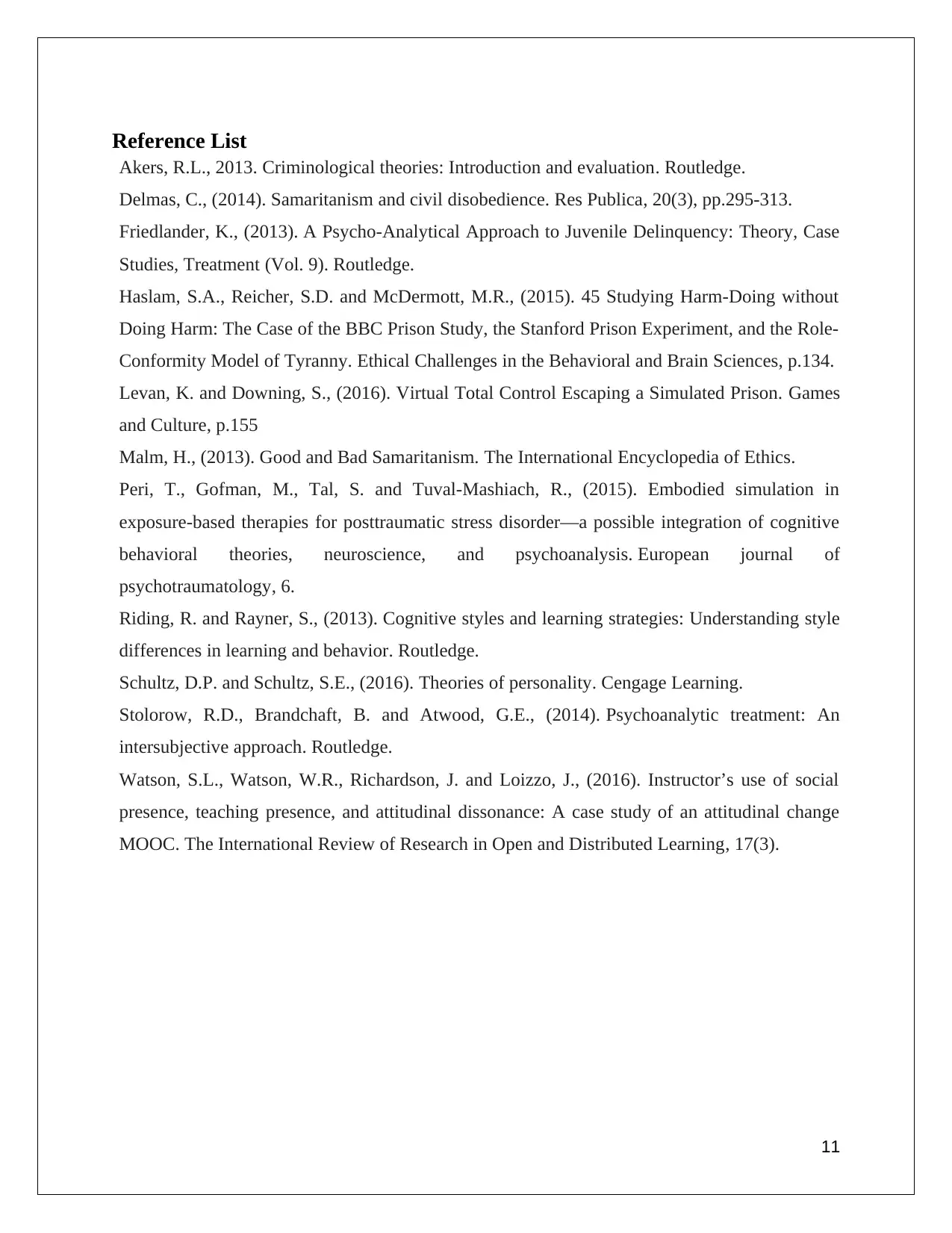
Reference List
Akers, R.L., 2013. Criminological theories: Introduction and evaluation. Routledge.
Delmas, C., (2014). Samaritanism and civil disobedience. Res Publica, 20(3), pp.295-313.
Friedlander, K., (2013). A Psycho-Analytical Approach to Juvenile Delinquency: Theory, Case
Studies, Treatment (Vol. 9). Routledge.
Haslam, S.A., Reicher, S.D. and McDermott, M.R., (2015). 45 Studying Harm-Doing without
Doing Harm: The Case of the BBC Prison Study, the Stanford Prison Experiment, and the Role-
Conformity Model of Tyranny. Ethical Challenges in the Behavioral and Brain Sciences, p.134.
Levan, K. and Downing, S., (2016). Virtual Total Control Escaping a Simulated Prison. Games
and Culture, p.155
Malm, H., (2013). Good and Bad Samaritanism. The International Encyclopedia of Ethics.
Peri, T., Gofman, M., Tal, S. and Tuval-Mashiach, R., (2015). Embodied simulation in
exposure-based therapies for posttraumatic stress disorder—a possible integration of cognitive
behavioral theories, neuroscience, and psychoanalysis. European journal of
psychotraumatology, 6.
Riding, R. and Rayner, S., (2013). Cognitive styles and learning strategies: Understanding style
differences in learning and behavior. Routledge.
Schultz, D.P. and Schultz, S.E., (2016). Theories of personality. Cengage Learning.
Stolorow, R.D., Brandchaft, B. and Atwood, G.E., (2014). Psychoanalytic treatment: An
intersubjective approach. Routledge.
Watson, S.L., Watson, W.R., Richardson, J. and Loizzo, J., (2016). Instructor’s use of social
presence, teaching presence, and attitudinal dissonance: A case study of an attitudinal change
MOOC. The International Review of Research in Open and Distributed Learning, 17(3).
11
Akers, R.L., 2013. Criminological theories: Introduction and evaluation. Routledge.
Delmas, C., (2014). Samaritanism and civil disobedience. Res Publica, 20(3), pp.295-313.
Friedlander, K., (2013). A Psycho-Analytical Approach to Juvenile Delinquency: Theory, Case
Studies, Treatment (Vol. 9). Routledge.
Haslam, S.A., Reicher, S.D. and McDermott, M.R., (2015). 45 Studying Harm-Doing without
Doing Harm: The Case of the BBC Prison Study, the Stanford Prison Experiment, and the Role-
Conformity Model of Tyranny. Ethical Challenges in the Behavioral and Brain Sciences, p.134.
Levan, K. and Downing, S., (2016). Virtual Total Control Escaping a Simulated Prison. Games
and Culture, p.155
Malm, H., (2013). Good and Bad Samaritanism. The International Encyclopedia of Ethics.
Peri, T., Gofman, M., Tal, S. and Tuval-Mashiach, R., (2015). Embodied simulation in
exposure-based therapies for posttraumatic stress disorder—a possible integration of cognitive
behavioral theories, neuroscience, and psychoanalysis. European journal of
psychotraumatology, 6.
Riding, R. and Rayner, S., (2013). Cognitive styles and learning strategies: Understanding style
differences in learning and behavior. Routledge.
Schultz, D.P. and Schultz, S.E., (2016). Theories of personality. Cengage Learning.
Stolorow, R.D., Brandchaft, B. and Atwood, G.E., (2014). Psychoanalytic treatment: An
intersubjective approach. Routledge.
Watson, S.L., Watson, W.R., Richardson, J. and Loizzo, J., (2016). Instructor’s use of social
presence, teaching presence, and attitudinal dissonance: A case study of an attitudinal change
MOOC. The International Review of Research in Open and Distributed Learning, 17(3).
11
1 out of 11
Your All-in-One AI-Powered Toolkit for Academic Success.
+13062052269
info@desklib.com
Available 24*7 on WhatsApp / Email
![[object Object]](/_next/static/media/star-bottom.7253800d.svg)
Unlock your academic potential
© 2024 | Zucol Services PVT LTD | All rights reserved.





